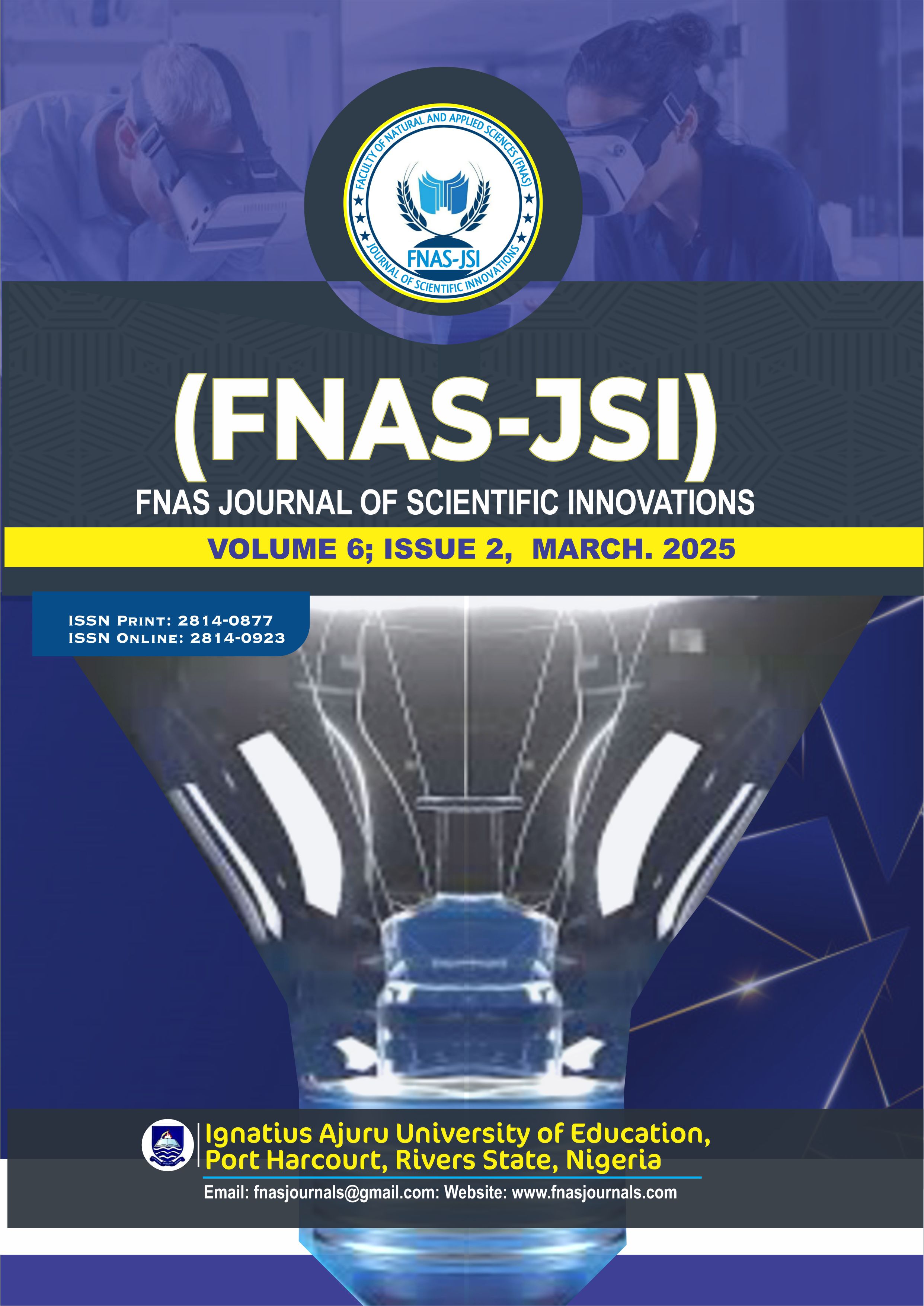Morphological variations of white yam (Dioscorea rotundata) treated with different concentrations of ethyl methane sulfonate
Main Article Content
Abstract
White yam (Dioscorea rotundata) is an essential staple crop in many tropical regions, contributing immensely to food security and livelihoods for millions of people. However, its cultivation is limited by factors such as low yield and lack of genetic diversity. To address these challenges, this study investigated the response of white yam to different concentrations and timings of Ethyl methane sulfonate (EMS), a chemical mutagen used to induce genetic variation. Minitubers obtained from single nodal vine cuttings with a leaf each previously treated with 0.5% and 1.0% concentrations with exposure durations of 1.0, 1.5, 2.0, and 2.5 hours were planted and allowed to grow into mother plants. Two months later, single vine nodes were carefully cut from the mother plants and planted directly into sterilized topsoil within a controlled environment, and morphological variations were evaluated using ANOVA (SAS 9.0 version), and differences in means were separated at P≤0.05 using LSD. At eight weeks, yam seedlings with EMS 1% treatment for 1 hour had the highest number of leaves (7.22 ± 0.53) and the longest vine (49.41 ± 3.60 cm) and produced the highest number of nodes count (7.19 ± 0.53), while the fewest leaves (3.88 ± 0.53) and the shortest vine (29.84 ± 3.60 cm) were recorded for the control. The highest leaf area (43.07 ± 1.84 cm²) was recorded for the seedlings treated with 0.5% for 2 hrs., and the lowest leaf area (30.27 ± 1.84 cm²) was recorded for 0.5% at 2.5 hrs. The largest tuber weight was obtained with EMS 1% for 1 hour (21.95 ± 4.89 g). The results suggest that EMS 1% treatment for 1 hour can significantly improve yam productivity and yield.
Article Details
References
Abid, M., Ali, S., Qi, L.K, Zahoor, R., Tian, Z., Jiang, D., Snider, L., & Dai, T. (2018). Physiological and biochemical changes during drought and recovery periods at tillering and jointing stages in wheat (Triticum aestivum L.). Scientific Reports, 8, 4615 DOI 10.1038/s41598-018-21441-7
Ahmad, A., & Asif, A. (2023). Mutagenesis in medicinal plants. In: Omics studies of medicinal plants. United Kingdom. CRC Press.
Asiedu, R., Alieu, S., & Sartie, A. (2010). Crops that feed the World 1. Yams. Food Security, 2, 305–315. https://doi.org/10.1007/s12571-010-0085-0
Balogun, M.O., Maroya, N., & Asiedu, R. (2014). Status and prospects for improving yam seed systems using temporary immersion bioreactors. Academic Journals, 13(15), 1614-1622.
Behera, M.J., Panigrahi, R.R., & Mishra, S.P. (2012). Analysis of EMS induced in vitro mutants of Asteracantha longifolia (L.) Nees using RAPD markers. Indian Journal of. Biotechnology, 11, 39–47.
Cvejić, S., Jocić, S., Jockovic, M., Imerovski, I., Radanović, A., Miladinović, D., & Prodanovic S. (2015). New genetic variability in sunflower inbred lines created by mutagenesis. Romanian Agricultural Research, 32, 1-8.
Ettien, J.B., Sorho, F., & Brahima, K. (2013). Screening of new yam clones (D. alata and D. rotundata) in nematode prone ecology of guinea savanna zone in West Africa. Journal of Applied Biosciences, 61, 4540–4550. https://doi.org/10.4314/jab.v61i0.85600
FAO STAT. (2020, December 10). www.fao.org/statistics/en
Gatarira, C., Sládeková, L., Nˇemeˇcková, A., Šimoníková, D., Paliwal, R.., Asfaw, A., Abberton, M., Badara, G., Asiedu, R., & Cížková, J. (2021). Cytological and Molecular Characterization for Ploidy Determination in Yams (Dioscorea spp.). Agronomy, 11, 1897. https://doi.org/10.3390/agronomy 11101897
Guo-Fu, L., Ana, P., Dawit Beyene, K., Carmel, P., Gary, H., & Amit, S. (2022). A Review of Viruses Infecting Yam (Dioscorea spp.). ResearchGate. https://doi.org/10.3390/v14040662
Hasan, N., Choudhary, S., Jahan, M., Sharma, N., & Naaz, N. (2022). Mutagenic potential of cadmium nitrate [Cd (NO3) 2] and ethyl-methane sulphonate [EMS] in quantitative and cyto-physiological characters of Capsicum annum L. cultivars. Ecological Genetics and Genomics, 22, 100110 DOI 10.1016/j.egg.2021.100110.
Luan, Y.S., Zhang, J., Gao, X.R., & An, L.J. (2007). Mutation induced by ethylmethanesulphonate (EMS), in vitro screening for salt tolerance and plant regeneration of sweet potato (Ipomoea batatas L.). Plant Cell, Tissue and Organ Culture, 88, 77–81. https://doi.org/10.1007/s11240-006-9183-2
Mignouna, H.D., Ellis, N.T, Knox, M., Asiedu R., & Ng, Q.N. (1998). Analysis of genetic diversity in Guinea Yams (Dioscorea spp.) using AFLP fingerprinting. Tropical Agriculture (Trinidad), 75, 224-229
Nwachukwu, E.C., Mbanaso, E.N.A., & Nwosu, K.I. (2008). The development of new genotypes of the white yam by mutation induction.
Price, E.J., Bhattacharjee, R., Lopez-Montes, A., & Fraser, P.D. (2017). Metabolite profiling of yam (Dioscorea spp.) accessions for use in crop improvement programmes. Metabolomics, 13, 1–12. [CrossRef]
Saba, N., & Mirza, B. (2002). Ethyl methane sulfonate induced genetic variability in Lycopersicon esculentum. International Journal of Agriculture
Sadik, S., & Okereke, O.U. (1975). A new approach to improvement of yam (Dioscorea rotundata). Nature, 254, 134–135. https://doi.org/10.1038/254134a0
Subuthi, P.K., Mohapatra, B.K., & Sinha, S.K. (1991). Use of pollen traits for early detection of induced micro mutations in wheat. Indian Journal of Genetics, 5(1), 101-111.
Syombua, E.D., Tripathi, J.N., Obiero, G.O., Nguu, E.K., Yang, B., Wang, K., & Tripathi, L. (2022). Potential applications of the CRISPR/Cas technology for genetic improvement of yam (Dioscorea spp.). Food and Energy Security, 11, e330. https://doi.org/10.1002/fes3.330
Umber, M., Filloux, D., Gélabale, S., Gomez, R.M., Marais, A., Gallet, S., Gamiette, F., Pavis, C., & Teycheney, P.Y. (2020). Molecular Viral Diagnosis and Sanitation of Yam Genetic Resources: Implications for Safe Yam Germplasm Exchange. Viruses, 12, 1101. https://doi.org/10.3390/v12101101
Viana, V.E., Pegoraro, C., Busanello, C., & Oliveira, A. (2019). Mutagenesis in rice: the basis for breeding a new super plant. Frontiers in Plant Science 10:1326 DOI 10.3389/fpls.2019.01326.
Villamor, C.C., & Cardinez, M.T. (2008) Application of induced mutation to increase yield of yam (Dioscorea alata L.). In Philippine Journal of Crop Science (Philippine

